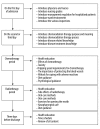Effectiveness of an Intervention to Promote Self-Efficacy on Quality of Life of Patients with Nasopharyngeal Carcinoma of the Zhuang Tribe Minority in Guangxi, China: A Prospective Study
- PMID: 28832557
- PMCID: PMC5578692
- DOI: 10.12659/msm.903205
Effectiveness of an Intervention to Promote Self-Efficacy on Quality of Life of Patients with Nasopharyngeal Carcinoma of the Zhuang Tribe Minority in Guangxi, China: A Prospective Study
Abstract
BACKGROUND Nasopharyngeal carcinoma (NPC) is endemic in China and patient self-management is poor. Minorities may suffer from psychological problems during treatments for NPC. This study aimed to implement an intervention to promote self-efficacy of minority patients (Zhuang tribe, Guangxi, China) with NPC to improve their quality of life (QOL). MATERIAL AND METHODS This was a prospective study of 120 patients with NPC treated at the First Affiliated Hospital of Guangxi Medical University (Guangxi, China), randomized to conventional care (n=60, controls) or conventional care plus self-efficacy interventions based on health education, behavior therapy, and psychological intervention (n=60, self-efficacy group). Self-efficacy was evaluated using the general self-efficacy scale, and QOL using the EORTC QLQ-C30. The questionnaires were completed at discharge, at 6 months, and at 1 and 2 years. The primary outcome was QOL. RESULTS There was no difference in QOL at baseline. From study start to hospital discharge, overall QOL scores decreased in both groups, but this decrease was more important in the control group (controls: -39.31 vs. self-efficacy: -27.04, P<0.05). After discharge, each functional field QOL scores and overall QOL increased with time in the 2 groups, and they were significantly higher in the self-efficacy group. CONCLUSIONS This intervention promoting self-efficacy could increase patients' own potential and initiative, enhance their confidence and ability to solve health problems, improve their coping with adverse effects of treatments, and have positive effects on their QOL. Self-efficacy theory-based interventions could be worth popularization during the treatment and recovery of minority patients with NPC.
Figures
Similar articles
-
Quality of life and coping styles in Chinese nasopharyngeal cancer patients after hospitalization.Cancer Nurs. 2005 May-Jun;28(3):179-86. doi: 10.1097/00002820-200505000-00003. Cancer Nurs. 2005. PMID: 15915060
-
Improvement in quality of life in patients with nasopharyngeal carcinoma treated with non-invasive extracorporeal radiofrequency in combination with chemoradiotherapy.Int J Radiat Biol. 2014 Oct;90(10):853-8. doi: 10.3109/09553002.2014.916579. Epub 2014 Jun 25. Int J Radiat Biol. 2014. PMID: 24758521 Clinical Trial.
-
Effects of Home Nursing Intervention on the Quality of Life of Patients with Nasopharyngeal Carcinoma after Radiotherapy and Chemotherapy.Asian Pac J Cancer Prev. 2015;16(16):7117-21. doi: 10.7314/apjcp.2015.16.16.7117. Asian Pac J Cancer Prev. 2015. PMID: 26514499 Clinical Trial.
-
Item selection in the development of quality of life scale for nasopharyngeal carcinoma patients.Ai Zheng. 2009 Jan;28(1):82-5. Epub 2009 Jan 24. Ai Zheng. 2009. PMID: 19448426
-
Outcomes of xerostomia-related quality of life for nasopharyngeal carcinoma treated by IMRT: based on the EORTC QLQ-C30 and H&N35 questionnaires.Expert Rev Anticancer Ther. 2015 Jan;15(1):109-19. doi: 10.1586/14737140.2015.961427. Epub 2014 Sep 18. Expert Rev Anticancer Ther. 2015. PMID: 25231774 Review.
Cited by
-
Movement Through Chemotherapy Delay to Initiation Among Breast Cancer Patients: A Qualitative Analysis.Patient Prefer Adherence. 2022 Mar 22;16:749-759. doi: 10.2147/PPA.S350412. eCollection 2022. Patient Prefer Adherence. 2022. PMID: 35345541 Free PMC article.
-
Effect of Implementing a Life Skills Program on the Perceptions of Aging and Self-efficacy in Postmenopausal Women: A Field Trial.Iran J Nurs Midwifery Res. 2022 Mar 14;27(2):157-162. doi: 10.4103/ijnmr.ijnmr_3_21. eCollection 2022 Mar-Apr. Iran J Nurs Midwifery Res. 2022. PMID: 35419262 Free PMC article.
-
Psychological intervention improves quality of life in patients with early-stage cancer: a systematic review and meta-analysis of randomized clinical trials.Sci Rep. 2024 Jun 9;14(1):13233. doi: 10.1038/s41598-024-63431-y. Sci Rep. 2024. PMID: 38853187 Free PMC article.
-
Effects of Cognitive Behavioral Therapy for Depression and Anxiety, Response Rates and Adverse Events in Patients with Locoregional Advanced Nasopharyngeal Carcinoma.Integr Cancer Ther. 2021 Jan-Dec;20:15347354211006179. doi: 10.1177/15347354211006179. Integr Cancer Ther. 2021. PMID: 33784875 Free PMC article.
-
Translation and validation of the Chinese version of medical maximizer-minimizer scale: a cross-sectional study.BMJ Open. 2021 Jan 6;11(1):e042432. doi: 10.1136/bmjopen-2020-042432. BMJ Open. 2021. PMID: 33408206 Free PMC article.
References
-
- Tao Q, Chan AT. Nasopharyngeal carcinoma: Molecular pathogenesis and therapeutic developments. Expert Rev Mol Med. 2007;9:1–24. - PubMed
-
- NCCN Clinical Practice Guildeines in Oncology (NCCN Guidelines) Head and Neck Cancers. Fort Washington: National Comprehensive Cancer Network; 2015.
-
- Lee AW, Lin JC, Ng WT. Current management of nasopharyngeal cancer. Semin Radiat Oncol. 2012;22:233–44. - PubMed
Publication types
MeSH terms
LinkOut - more resources
Full Text Sources



